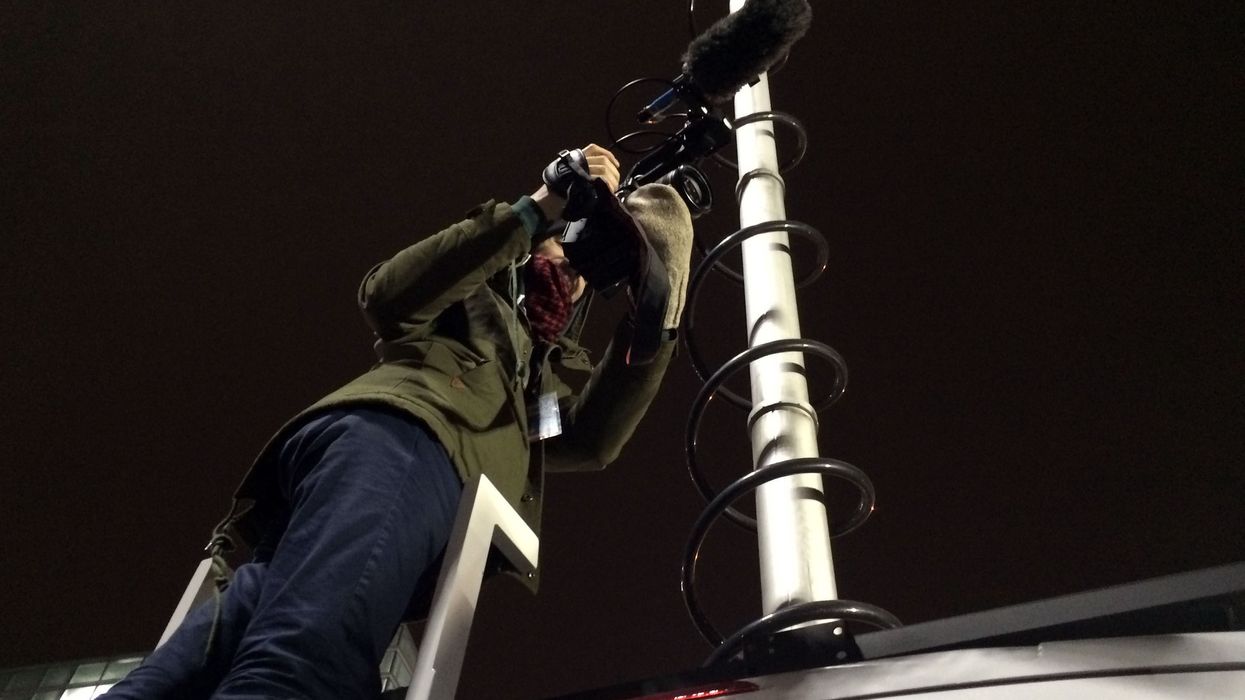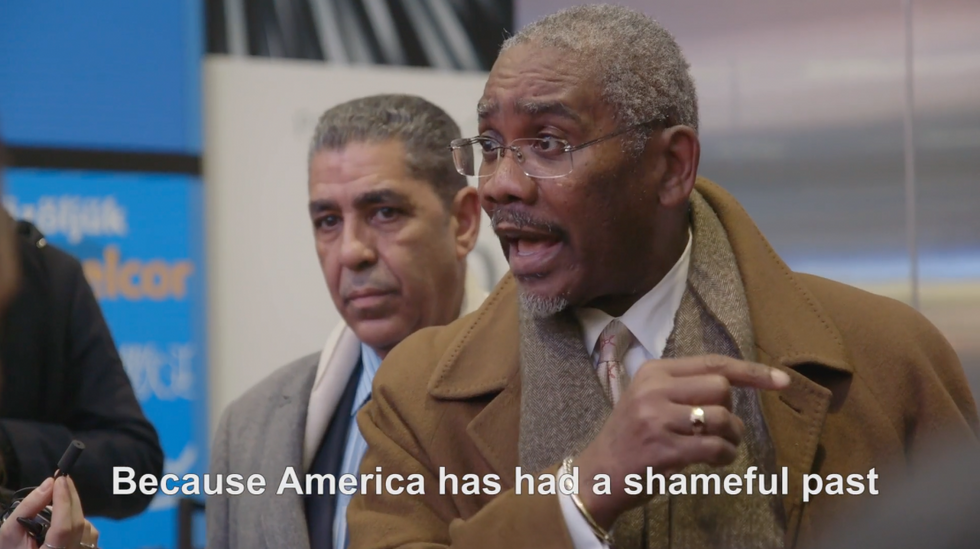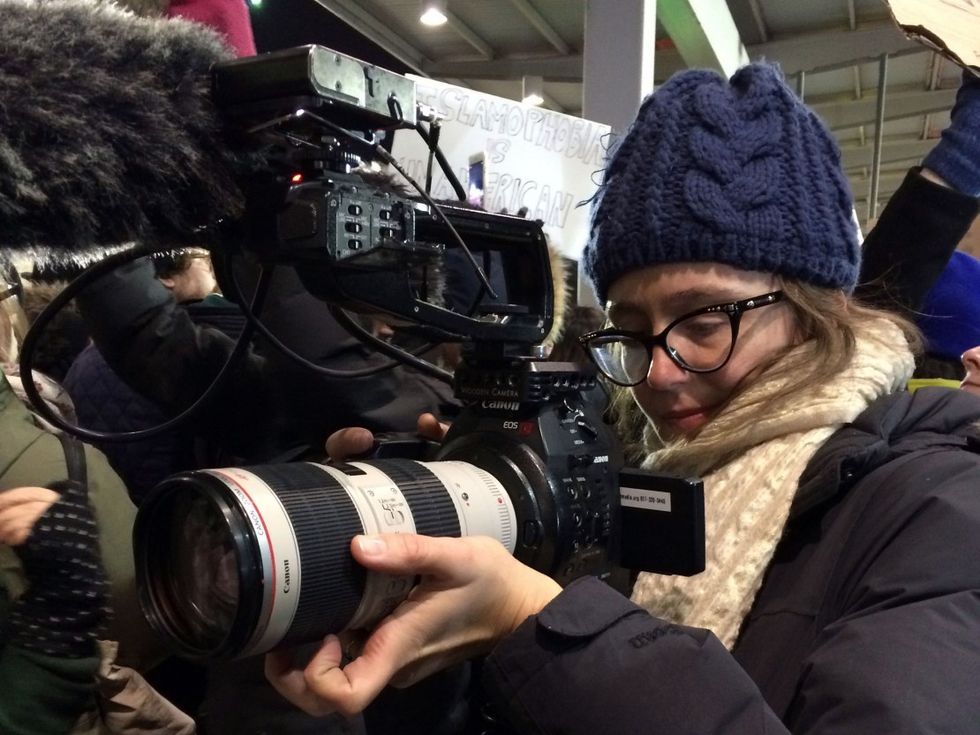Filming a Protest? 6 Tips to Capture the Action
If you're heading out to capture the political moment, keep these strategies in mind.

[Editor's note: this article was contributed to by members of Meerkat Media with contributions from Alex Mallis, Dara Messinger, Eric Phillips-Horst, and Zara Serabian-Arthur.]
As sensational headlines become currency in the age of internet and “fake news,” short documentaries are playing an increasingly important role in the dissemination of nuanced perspectives, and filmmakers have a unique ability to capture and share actions as they happen.
Enter the public protest: a form of expression as old as civilization and certainly a vital characteristic of our relatively young American democracy. Indeed, our right to peaceful assembly is the very first amendment to our constitution.
You have the right to film police so long as you keep a "reasonable distance" and do not interfere with the activity of law enforcement.
In our media and film collective, Meerkat Media, we’ve already had some success quickly releasing time-sensitive documentaries, such as Into the Streets. Now, we’re focusing energy and resources towards furthering these pieces to cover burgeoning protests and actions. Inspired in part by leftist filmmakers of the 1960s, we want to bridge the “schism between the experience of events, local and distant, and their representation in the mass media.” With so much happening so fast, we feel it important and valuable for filmmakers of all kinds to help spread the messages emanating from activists and policy makers on the ground. We want to inspire people to participate. We want our projects to sit in solidarity with grassroots organizations and elevate the work they are doing and make it more visible.
With the release of our most recent short film, America Is My Home (below), we’d like to share six tips to keep in mind if you decide to head out into the field to capture a rally or protest:
1. Stay mobile
Protests more often than not mean you’ll be in a crowd. There may be no safe place to store gear, and you may be on your feet for hours. Only take what you can carry while you simultaneously shoot. And this might be the best argument for shooting with a DSLR or lighter cinema camera. In our case, a common field-kit is as follows:
Camera
- Canon C100
- 24-70mm Tamron (stabilized)
- 70-200mm Canon (in a belt-loop pouch)
- Extra batteries
Audio
- Schoeps Shotgun mic
- Lectrosonics wireless lav kit
Stabilization
- Manfrotto monopod
One trick we found beneficial is to use the lav mic like a wireless shotgun. This was especially useful for capturing impromptu conversations or press conferences where we couldn’t attach a lav to the person speaking. One person from our team would simply stick their hand out as close to the speaker’s face as possible. We didn’t have time to sync back at the office, so all audio went directly into camera. It’s a simple and easy alternative to a wireless shotgun rig. You can see Dara’s hand with the lav mic peeking into the bottom left of the below frame:

2. Know your rights and be safe
As a filmmaker, you have the right to film police so long as you keep a "reasonable distance" and do not interfere with the activity of law enforcement. (Keep in mind that if an officer asks you to move away, you have three chances to do it before they have the right to cuff you.) At no time may police confiscate your equipment without a warrant. Furthermore, photography in public spaces is a constitutional right, and that includes filming in federal buildings, transportation facilities, and filming police and other government officials carrying out their duties. In private spaces, filming is at the owner's discretion. In short, know where you are.
Also make sure that you are keeping the safety of your subjects in mind. Avoid putting someone in harm's way or in legally compromising positions just to get the shot you want. The ACLU has put together a great resource to learn more about what to do if you are stopped or detained while documenting a public event.
The mundane details of everyday life can serve as a great juxtaposition for whatever action you are covering.
3. Think like an editor
Get the establishing shots. Get the cutaways. Get the details. Alternate between the three in a cycle: you might have to ditch your location with no warning. As much as you can, imagine yourself in the editing room. What shots would you want? On our most recent shoot, we called a trusted editor (not at the protest) to hear their list of shot ideas. We cross-referenced their suggestions with what we had, and then made sure to get the rest. Whenever you think you have enough footage to leave, take another 15 minutes to get some nice wides, or even cutaways of whatever was happening next to the protest. The mundane details of everyday life can serve as a great juxtaposition for whatever action you are covering.
Also, as you take each shot, count to ten. Film ten full seconds on any shot you compose. Hold it steady. It’s always better to commit to one, clean shot—resisting the urge to make minor adjustments in the middle of it—than to get two or three mediocre ones. This is especially important to remember in the heat of the moment.
If you’re grabbing establishing or inserts, frame your shot, take it, and cut. Try not to get it again unless it’s definitely a new idea. Save your editor the hassle of sorting through a mountain, and instead give them a series of well-polished foothills.
4. Work in a team
With your eyes glued to the camera, it’s a huge help to have a producer thinking a few steps ahead. Let the cameraperson focus on composition while somebody in a producer role can wrangle interviews and generally watch the shooter's back. One of the biggest challenges of covering protests is knowing where to be, and what to shoot. Division of labor allows for somebody to keep their eyes on the overarching narrative that may (or may not) be unfolding in real time. This is where our collective’s all-hands-on-deck mentality truly shapes our filmmaking process. Using a group text message chain is especially helpful in a crowded situation. Include everyone. It’s fine if not all the information is relevant to every member all the time, as it keeps people informed and solidifies all of you as a team. In crowded protests, text communication can also get cut off, so make sure you've set up an offline meeting place in case you get separated.
If you're not in a collective, you're still not alone! Enlist your friends and collaborators to come on board. Ideally, there should be a more general discussion beforehand. Talk about your goals and style, and who's available for what. Identify whatever resources you have versus what you might need. Finally, think outside your zone of familiarity. Working with people from diverse backgrounds helps to maximize the potential for gathering compelling content; everyone’s lived experience naturally gravitates them towards specific people and ideas. A diversified team not only prepares you to walk away with better footage, it also helps to solidify connections and build bridges for future projects.

5. Go behind the curtain
Beyond the obvious sweeping wide-shot visual that can render a protest so compelling, there is often a deeper story to be told. Invest time into identifying which groups may be involved in the planning and execution of a given protest or action. Reach out to them ahead of time. Who is organizing and why? Having a point-person on the organizational level is a hugely valuable resource in what can otherwise be a chaotic scene.
Speak with and interview participants, and make sure they understand that you are filming and that you have their permission to do so. Who is participating and why? Start with easy, open-ended questions to establish the scene. “Where are we? Why did you come here today? What do you hope to see as a result?” Listen closely and be ready to follow-up on any interesting points they touch upon. Get their names (clarify the exact spelling), and their contact info.
Remember, you may be the expert on how to shoot something beautifully, but others are the experts on what the issues are, and we need to listen and learn from them. Wherever possible, speak with organizers beforehand to hear from them what narratives/perspectives they want to be lifting up, and be sure to share the piece with them when it’s done.
While some of us are out shooting, others prepare for what might be an all-nighter editing session.
6. Turn your work around quickly
We’ve found our protest coverage to be most successful when we get it online within a few days—ideally, within the same news cycle. Of course, this can be a daunting task. And to that end, we try to employ a clear division of labor. While some of us are out shooting, others prepare for what might be an all-nighter editing session. As the edit progresses, we dedicate one or two people to start working on copy and outreach. We make a list of relevant contacts and design a personable form-email to use when reaching out.
Good luck, and most of all, be safe. For additional advice, tutorials, and issue-specific guides, we highly recommend visiting the WITNESS Library.
To see more of Meerkat Media's work, follow them on Vimeo or Facebook.











